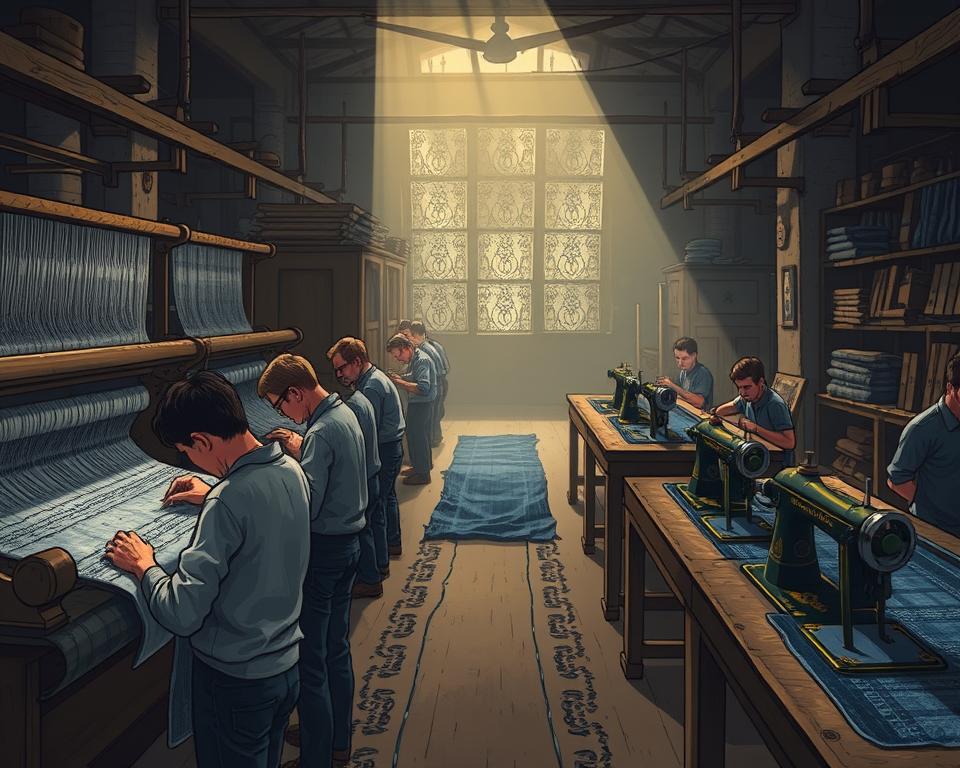Selvedge Denim Material Explained: Everything You Should Know
A single pair of vintage Levi’s 501s from the 1940s recently sold for $87,400 at auction. Why were these trousers valued higher than a high-end automobile? It all comes down to their selvedge denim fabrication.
This high-end denim stands for more than simple material. It recalls the era when James Dean donned his 501s in Rebel Without a Cause, and Marlon Brando epitomized cool in The Wild One. These cultural icons didn’t just wear jeans. They chose black selvedge denim fabric wholesale woven on antique shuttle looms.
Craft denim derives its title from the self-finished perimeters that avert fraying. “Selvedge” merges “self” with “edge” to denote this distinct weaving technique. Differing from factory-made denim, each yard of selvedge denim material requires patience and expertise to craft.
The surface narrates a tale via gentle inconsistencies and organic variations. Each iteration gains personality as the indigo lightens. This unique aging grants heritage denim its special appeal among collectors and fashion devotees alike.
Many believe premium denim lasts longer than regular jeans. The truth is more nuanced. Selvedge crafting produces lovely material with tidy edges and robust texture. Yet durability hinges on cotton grade and weight, rather than solely on weaving method. What differentiates artisanal denim is its knack for aging with grace and creating singular fading designs in the long run.
Understanding Selvedge Denim Material
Selvedge denim fabric is distinct from regular denim due to its unique construction and finished edges. It’s named for its “self-edge,” a tightly woven band that prevents fraying. This premium material embodies a dedication to slow fashion and traditional craftsmanship, setting it apart from mass-produced denim.

The Meaning Behind Self-Edge Construction
The word “selvedge” fuses “self” with “edge,” indicating material with a tidy, sealed edge. This narrow selvage runs along both sides, removing the requirement for added finishing. Heritage mills make it about 30–32 inches wide, as opposed to modern denim’s 60-inch breadth.
Shuttle Looms and Their Unique Fabric Borders
Shuttle-loomed denim’s essence stems from classic weaving machines operating more slowly. They pass one weft yarn across all warp threads in a single sweep. This approach produces:
- Natural irregular slubs
- A gentler hand-feel compared to contemporary denim
- Tightly bound edges that won’t fray
- Authentic irregularities cherished by denim enthusiasts
Selvedge vs. Standard Denim
Conventional denim is woven on projectile looms sending weft yarns across wider bolts. This method leaves loose threads at the edges, needing overlocked seams to prevent fraying. Selvedge denim fabric, however, requires extra time in production. It offers superior durability and a unique aesthetic, justifying its higher cost.
The Heritage and History of Shuttle-Loomed Denim
The journey of heritage denim started in American textile mills in the 1800s. Shuttle looms were key, weaving fabric with tightly woven edges to prevent fraying. This method produced indigo-dyed denim at a slow, meticulous pace, ensuring each yard was crafted with care. The narrow width of this fabric became a hallmark of artisanal denim production.
From 1800s American Mills to Modern Revival
For upwards of a century, American factories leaned on shuttle looms. Brands like Cone Mills and White Oak supplied premium denim to workwear companies. By the 1970s, quick projectile looms dominated, displacing most shuttle machines. This shift was driven by the need for cheaper, mass-produced jeans. Many historic mills closed or modernized, leaving vintage looms to gather dust.
How Japan Revived Selvedge Denim
During the 1980s, Japanese mills resurrected U.S. shuttle looms. Leading the charge were the Osaka Five brands:
- Studio D’Artisan
- Evisu
- Fullcount
- Warehouse
- Denime
They combined American heritage style and Japanese meticulousness. They studied old Levi’s patterns, recreating classic indigo-dyed denim textures. By 2000, Japan dominated the artisanal denim market globally.
Relevance of Classic Weaving Now
Shuttle looms create special fabric features unmatched by modern equipment. This slower method fosters subtle irregularities and fuller indigo soak. Premium denim enthusiasts cherish these imperfections as signs of authentic craftsmanship.
| Shuttle Loom Features | Modern Loom Features |
|---|---|
| 29-31 inch fabric width | 60+ inch fabric width |
| 3-4 yards per hour | 15-20 yards per hour |
| Natural irregularities | Uniform texture |
| Self-finished edges | Cut edges requiring overlocking |
Making Premium Denim on Antique Looms
Premium denim production kicks off with the steady rhythm of antique shuttle looms. These machines differ from today’s technology. They weave yarn across the fabric width in a single thread, locking the edges without finishing. This method ensures selvedge denim has a clean, non-fraying edge.
Vintage looms weave at a slower pace, producing just 5-6 meters of selvedge denim material daily. This sharply contrasts with current machines that manage 200 meters. The slower speed benefits the yarn in several ways:
- Reduced fiber tension yields a gentler feel
- Organic irregularities stay put, granting unique texture
- Varied surfaces produce signature fading
- Narrow fabric width (typically 29-32 inches) reduces cutting waste
Manning these age-old looms calls for seasoned artisans. Operators fine-tune tension, track cadence, and carry out maintenance. Every loom boasts its own personality. Several originate from the 1920s and rely on skills handed down over decades. This hands-on approach makes shuttle-loomed denim a true artisan product.
The narrow width of dry denim from vintage looms has a practical benefit. Denim craftsmen can employ the finished edge as the outseam, cutting waste. This showcases the fabric’s authentic construction. Every roll has its own story, with subtle variations that mass production can’t replicate.
Differentiating Raw Denim from Selvedge Denim
Many denim enthusiasts confuse raw denim with selvedge denim fabric. This misunderstanding crops up while seeking high-end jeans. The truth is, these terms describe different aspects of denim production. Knowing the difference helps you make better choices and appreciate each type’s uniqueness.
Why Selvedge Isn’t Always Raw
Selvedge indicates the shuttle-loom weave that forms self-finished borders. Raw denim means unwashed fabric straight from the mill. A selvedge raw denim supplier may stock washed and unwashed varieties. Labels such as Naked & Famous make selvedge jeans, occasionally pre-rinsed or with elastane.
The loom process stays constant. Yet, the finishing process changes everything about the fabric’s feel and look.
Washed and Unwashed Denim Compared
Each denim item originates as dry denim before laundering. Mills produce both standard and selvedge versions unwashed. The principal distinctions are:
- Raw denim evolves custom fade patterns via use
- Rinse-treated denim provides quick comfort and sizing stability
- Sanforized raw stays closer to original measurements after first wash
- Unsanforized denim shrinks notably upon soaking
Breaking Down Common Misconceptions
Not all raw denim comes from shuttle looms. Contemporary projectile looms likewise churn out unwashed textile. The appeal often overlaps because buyers value durability, personalization, and craftsmanship in both selvedge and raw denim. Each style lures denim aficionados ready to devote time for bespoke fades.
Identifying Authentic Selvedge Denim Features
When you’re in the market for herringbone selvedge denim fabric, being able to spot genuine selvedge denim material is key. It separates you from everyday customers. Genuine selvedge denim boasts characteristics missing in standard denim. Understanding these features ensures you’re investing in authentic premium denim.
Spotting the Signature Selvedge ID
The simplest way to identify selvedge denim is by checking the outseam. Cuff your jeans and check the outer-leg seam. Real selvedge denim shows a neat, sealed edge with dyed yarns interwoven. This self-finished edge eliminates the need for overlocking stitches found on regular denim.
Rolling your cuffs unveils the selvedge ID, giving your outfit a signature detail. The tinted edge threads flow uninterrupted along the outseam, crafting that iconic denim aesthetic fans love. Regular jeans feature raw edges secured with serger stitches to avoid fraying.
Quality Construction Hallmarks
Top-tier premium denim reveals itself by key build features:
- Compact, consistent weave without loose fibers
- Clean selvedge edges without additional stitching
- Stable colored yarn running the full outseam
- Heavy fabric weight characteristic of shuttle looms
Why Rainbow and Redline Selvedge Are Unique
Rainbow selvedge incorporates varied colored threads in the ID, yielding a vibrant multicolor border. Redline selvedge, the iconic type, employs red threads in the ID and hails from classic U.S. mills. These unique selvedge forms carry premium prices thanks to their scarcity and aesthetic allure. Brands often showcase these details in listings, aiding you in spotting genuine heritage denim.
What Drives Artisanal Denim Prices
Newcomers are often astonished by artisanal denim price tags. Selvedge jeans often cost 3–5× more than factory-made pairs.
Comprehending what drives these costs shows the actual value of premium denim.
Shuttle looms run far more slowly than contemporary looms. While industrial looms produce fabric quickly, vintage shuttle looms weave only 1-2 meters per hour. This deliberate procedure turns a roll of heritage denim into a multi-day project.
The slender breadth of selvedge fabric hikes up costs. As opposed to 60-inch standard denim, shuttle-loom premium denim is merely 28–32 inches across. This narrower width requires more careful cutting and planning to use the fabric efficiently.
Artisan denim is produced in limited lots. Firms such as Okayama’s White Oak and Kuroki favor excellence over volume. They rely on veteran craftsmen who supervise every phase:
- Hand-checking yarn tension
- Adjusting loom settings for each fabric type
- Inspecting every meter for flaws
- Managing rope-dyeing processes that take weeks
These artisans treat denim-making like fine art. They experiment with unique yarns and perfect indigo-dyeing recipes passed down through generations. By investing in heritage denim, you support mills preserving textile traditions and workers committed to their craft.
Where to Buy Black Selvedge Denim Fabric Wholesale
Premium denim availability now reaches beyond Japan’s heritage mills. American brands now compete, providing a wide range of black selvedge denim fabric wholesale. To find the best supplier, it’s essential to understand quality markers and the origins of authentic materials.
Identifying Quality Wholesalers and Mills
Quality suppliers emphasize heritage weaving and a deep passion for craftsmanship. When searching for a selvadge raw denim fabric wholesaler, look for mills that use vintage shuttle looms. These suppliers offer detailed fabric specs, including weight, weave pattern, and dye methods.
Gold Selvedge Denim Fabric Manufacturers to Know
Gold-ID selvedge producers spotlight rich edge threads, boosting denim opulence. Top factories craft these niche fabrics in small batches, drawing boutique labels. The gold-ID thread bestows an exclusive trim, differentiating them from usual choices.
Where to Find Nep Denim and Other Specials
Unique textiles such as nep denim require dedicated sourcing paths. Nep denim shows deliberate specks for standout aesthetics. Dealing straight with manufacturers secures supply of these specialty textiles.
| Fabric Type | Minimum Order | Lead Time | Price Range per Yard |
|---|---|---|---|
| Black Selvedge | 500 yards | 6-8 weeks | $12-18 |
| Gold ID Selvedge | 300 yards | 8-10 weeks | $15-22 |
| Nep Denim | 400 yards | 10-12 weeks | $14-20 |
Selvedge Styles and Variants
Selvedge denim circles stretch beyond simple indigo. Today, mills create a wide range of textures and patterns. These demonstrate shuttle-loom weaving’s flexibility. Ranging from faint surface quirks to striking patterns, they deliver one-of-a-kind personality that evolves elegantly with use.
Understanding Slub Denim Texture
Slub denim’s trademark rough texture stems from uneven yarns. These yarns have thick and thin spots, creating a fabric surface with natural variations. Woven on shuttle looms, they form slub-textured selvedge that fades unpredictably.
Each pair of jeans made from slub denim develops its own unique pattern. The raised slubs fade differently than the flat parts, ensuring no two pairs look alike.
Herringbone Selvedge Traits
Herringbone selvedge textile shows a zigzag design similar to fish bones. The pattern forms diagonal ribs that reverse direction periodically. This design enhances appearance and amps up the material’s toughness.
Labels such as Iron Heart and The Strike Gold often employ this weave in their high-end lines.
Striped Denim and Other Unique Weaves
Striped denim fabric incorporates contrasting yarns to create vertical or horizontal lines. Workrooms produce these stripes by alternating colored yarns in the weave. Common variations are:
- Hickory stripe with alternating indigo and white
- Railroad stripe featuring thin pinstripes
- Wabash stripe with printed dots over stripes
| Fabric Type | Visual Pattern | Fade Characteristics |
|---|---|---|
| Slub Denim | Bumpy, irregular surface | High contrast, uneven fading |
| Herringbone | Zigzag diagonal lines | Subtle vertical streaking |
| Striped Denim | Alternating color bands | Pattern remains visible after fading |
Maintaining Your Heritage Denim
Your heritage denim calls for tailored care to grow its special character. Raw and dry denim, unlike typical jeans, change shape with wear. They form custom fade stories unique to you.
The first few weeks with artisanal denim can feel stiff and uncomfortable. This is normal. The material requires wear to relax and hug your silhouette. Some denim enthusiasts speed up this process by wearing their jeans in the shower or doing squats while damp. Others prefer a slower, more natural break-in period.
Raw denim develops its best fades when you wait to wash it. Skin oils and regular friction form whiskers by the knees and honeycombs at the rear. Numerous denim heads wait half a year before the initial wash, with some waiting a full year. This patience rewards you with high-contrast fades unique to your movement patterns.
When washing dry denim, flip it and rinse in cold water. Skip the spin cycle and hang dry away from direct sunlight. Some choose hand-washing in a tub with mild soap. Avoid hot water and dryers, as these can cause unwanted shrinkage and fade loss.
Your heritage denim investment grows more valuable with proper care. Every wear layers character, ensuring your jeans are uniquely yours. The firm break-in becomes a flexible second skin mirroring your daily life.
Where You Can Purchase Quality Indigo Denim Now
Selvedge denim’s comeback has created fresh opportunities for fans. Large chains now offer indigo denim, while niche shops continue premium slow-fashion offerings. This helps buyers locate real selvedge choices across price ranges for any budget or taste.
Levi’s sells its 501 Original Fit Selvedge for $148, bringing heritage craft to more people. Uniqlo carries Selvedge Straight Jeans for $50, drawing budget-conscious style seekers. For upscale choices, Buck Mason presents Japanese Loom State Selvedge Full-Saddle Jeans at $248. Iron Heart elevates artisan denim with its 634s-18 Vintage Denim for $385, sold at Self Edge.
American brands like Todd Snyder and Buck Mason now compete with Japanese specialists in the selvedge denim market. They realize that classic weaving methods and excellence underpin slow-fashion success. Whether shopping online or in physical stores, quality indigo-dyed denim is more accessible than ever to American consumers who cherish authentic craftsmanship.

